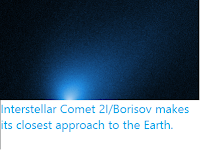Comet C/2010 U3 (Boattini) will make its closest approach to the
Earth on Tuesday 28 January 2020, reaching a distance of 8.22
AU from the Earth (822%
of the distance between the Earth and the Sun, or 1 229 500 000 km, or slightly less than the distance at which the planet Saturn orbits the Sun). The comet will not be visible at this time as it is behind the Sun.
Comet C/2010 U3 (Boattini) (between the two vertical lines at the centre of the image), seen on 29 May 2019 from Japan. Toshihiko Ikemura/Hirohisa Sato/Seiichi Yoshida.
C/2010 U3 (Boattini) was discovered on 31 October 2010 by astronomer Andrea Boattini, working at the
University of Arizona's Mt. Lemmon Survey at the Steward Observatory on Mount
Lemmon in the Catalina Mountains north of Tucson. The designation C/2019 U3 implies that it was the third comet discovered in the second half of October 2010 (period 2010 U). Surprisingly C/2010 U3 (Boattini) was found to be active (i.e. producing a coma due to material being ablated from its surface by solar heating in November 20015, while at a distance of 25.8 AU from the Sun (slightly inside the orbit of the planet Neptune), making it the most distant object upon which such activity has been seen.
Modelled morphology of comet C/2010 U3 (Boattini) with inclusion of the Lorentz force. Dates in GMT and scale bars are labelled in each panel, in arc seconds (
the whole sky - including the but behind the Earth - is divided into
360 degrees, each degree into 60 minutes and each minute into 60
seconds). The yellow arrows mark the position angles of the antisolar directions, while the white ones mark the position angles of negative heliocentric velocity. Equatorial north is up and east is left. Hui et al (2019).
C/2010 U3 (Boattini) has an unknown period
and a highly eccentric trajectory tilted at an angle of 55.5° to the plane of the Solar System, that takes it from 8.45 AU from the Sun at
perihelion (845% of the distance between the Earth and the Sun) to an
unknown outer orbital point, somewhere beyond the Kuiper Belt, in the
Oort Cloud. It is considered to be a hyperbolic comet, an object from
the Oort Cloud (or possibly even the interstellar space beyond), that
has been nudged onto a trajectory that takes it through the Inner Solar
System by an encounter with another Oort Cloud body or possibly the
gravity of another star or other extra-Solar System object. Such comets
are not expected to make return visits to the Inner Solar System, but
rather are thrown out of the Solar System altogether by a gravitational
slingshot caused by their close encounter with the Sun. However in the case of C/2010 U3 (Boattini) the current passage through the Inner Solar System is not thought to be the first; it is calculated to have made a similar visit around 1.86 million years ago.
The calculated trajectory and current position of C/2010 U3 (Boattini). Minor Planet Center.
See also...









